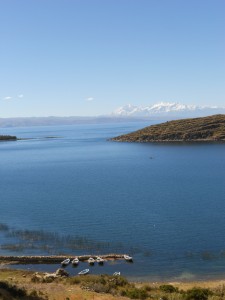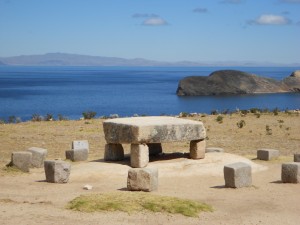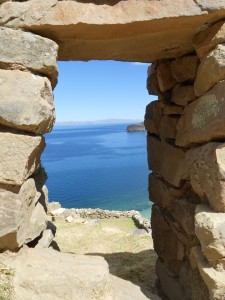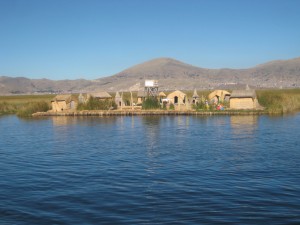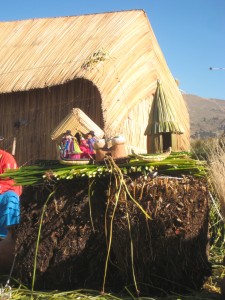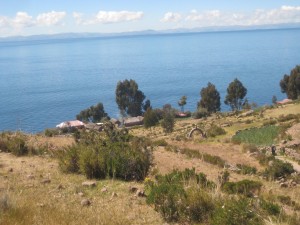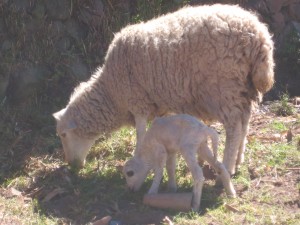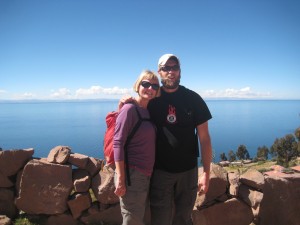Lake Titicaca is the world’s largest high altitude lake and is shared between Bolivia and Peru. It is famous for its floating islands made of reeds and for being the site of the origination of the Incas.
Mike and I had spent 7 nights in La Paz over the past 2.5 weeks, and it was finally time to head north. The bus from La Paz was 3 hours of discomfort but with amazing views of the mountains and the lake. Unfortunately, the 2 people sitting in front of us had too much to drink the night before, and they passed out with their seats fully reclined so that their heads were almost in our laps, resulting in zero leg room for us! I was relieved to get off the bus after arriving in Copacabana.
Copacabana is a small town situated right on Lake Titicaca and the main tourist town to visit the Isla del Sol. The town’s main street is filled with tourist restaurants and shops. It was strange to see so many gringos, but we were now firmly on the gringo trail during peak season. We did run into Tina, who was on our salt flat tour, and it was fun to catch up on our past few weeks of adventures.
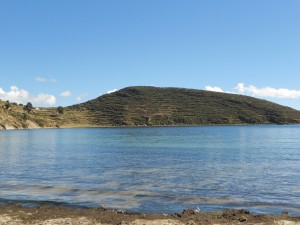
There is not much to do in the town itself except eat and relax. Our afternoon snack was nachos and the description on the menu was “little leaves of corn, avocado, tomato, and cheeseâ€. It took me a minute to figure out that little pieces of corn were chips, but I think the bigger surprise was that they turned out to be cheese Doritos!
Our lazy afternoon in the sun was followed by a short but steep hike up to a lookout above town for sunset. We misjudged the timing so we ended up running the steps to the very top to see the very end of the sunset. The views of the sun setting over Lake Titicaca were amazing, and it was also neat to see the pretty hills surrounding the town.
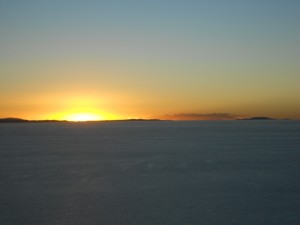  The following day, we set out to explore Isla del Sol (Island of the Sun), which is a 3 hour boat trip from Copacabana. Our boat was packed full of tourists for the slow journey while we occasionally inhaled the exhaust from engines. Upon arrival, we were greeted by a tour guide to show us around the island. The only problem was that he didn’t speak any English, and he spoke Spanish so fast that we only understood 5% of the words. So after trying our best and learning nothing, we ditched the group and explored the Inca ruins on our own.
 The following day, we set out to explore Isla del Sol (Island of the Sun), which is a 3 hour boat trip from Copacabana. Our boat was packed full of tourists for the slow journey while we occasionally inhaled the exhaust from engines. Upon arrival, we were greeted by a tour guide to show us around the island. The only problem was that he didn’t speak any English, and he spoke Spanish so fast that we only understood 5% of the words. So after trying our best and learning nothing, we ditched the group and explored the Inca ruins on our own.
The Incas believed that the sun and the earth were born on this island, and so they built a temple complex here. Titicaca means “puma rock,†and the island is in the shape of a puma which is a sacred animal in the Inca religion. This is all Mike and I understood of our short time with the tour guide, and that was just because he was standing by a poster with both the island and a puma head on it.
The 45 minute hike to the ruins was on stone pathways through terraced farms, and it really reminded us of our trek in Nepal. There was even a lady sitting outside her house to tell us we were going the wrong direction. The ruins were set high on the island and had amazing views of the sparkling blue lake and the Bolivian snowy peaks. As we wandered around we found the main temple, the altar, and a few houses. It was fun to walk through them and guess at what everything was once used for as there were no signs of explanation.
We had the option of walking to the other end of the island to catch the boat, but we opted just to return from where we started instead because it was extremely hot, and we were both still feeling the effects of our climb. The boat ride back to Copacabana was slow but less crowded so much more comfortable. Our last night in Bolivia was a candle lit dinner, and we shared a bottle of Bolivian wine.
On May 31, we entered our 19th country on this trip and our last segment of our year long journey. The bus from Copacabana to Puno was much more comfortable than the last bus! Getting over the border was easy until I saw that the Peruvian border control stamped my passport with April 31st instead of May 31st. Luckily, I caught the mistake before we left the border and was able to get it fixed with an ‘X’ through the wrong stamp and a new stamp added. Hopefully it doesn’t cause problems when we leave Peru!
Puno is the main tourist town for Lake Titicaca on the Peruvian side and the gateway to the floating islands. The town was described to us by other tourists as a dump, but it ended up being okay. It is a large town without a nice waterfront, but the main square area is nice. We spent our first afternoon in Peru getting set up for our island tour for the following day and getting caught up on journals.
On our walk to dinner we experienced our first Peruvian parade around the main plaza. The place was packed with observers, and the parade included several bands and children dressed up in costumes carrying pictures of animals. We never found out what the occasion was, but it was fun to watch the parade. At dinner, we both tried alpaca for the first time. It was delicious and very tender. I think I liked it better than the llama I tried in Argentina.
Our last day on Lake Titicaca was the best with an all day tour of the floating islands and Isla Taquille. I was really excited to visit the floating islands and see how they were constructed. The islands were only a 40 minute boat ride from Puno. Each island was 100’ by 200’ with 4 houses on each island. The islands were close to each other, and there was a main waterway acting as the main boulevard for the village. Around the village were reeds for as far as we could see which helped camouflage the villages from anyone looking from Puno.
The Uros people created the islands to protect them from pre-Inca attackers. The construction of each island takes 1 year and once completed will last 60 years. The island floor is reeds, and when you walk on it your feet sink a little. Also, when a boat passes the island, the whole island moves with the waves!
Once we arrived to one of the islands, the families welcomed us, and we sat down to learn about their culture and the construction of the island. The first step of the process is to harvest large pieces of the reeds’ roots. The best time of year is during rainy season when the roots start to float. Each island has 3 blocks or so. The blocks are moved to the desired location, sometimes 7km away. Then the reeds are cut at the base, still allowing for the plants to live. Next, stakes are pounded into each block, and the stakes are tied together with rope made of dried reeds. Eventually, the blocks will merge into 1. The cut reeds are laid down layer by layer each facing the opposite direction to create a crisscross of reeds. Additional reeds are placed where the houses will be built for additional support. The houses are 1 room only as the cooking is all completed in the common area outside.
As the head of household was describing the building process, the local women passed out reed roots for us to eat. They tasted like cucumbers. Reed roots and fish are the staples of their diet. After the demo, we toured the houses and looked at their handy-crafts for sale. Then we loaded onto a boat made of reeds for a cruise to another island. Amazing how they make everything that they need out of reeds!
Following our floating island tour, we returned to our speed boat to travel to Isla Taquille, which is 34 kilometers from Puno. The island’s tribe is known for their costumes and weaving. When we arrived, we walked 30 minutes uphill to the town center. The views were spectacular of the sapphire blue lake and the island farms. One farm had lambs that were so small and cute standing next to their big mamas! It made me not want to eat lamb ever again!
The main square had a local community shop selling the locally made hats, gloves, and scarves. Everything was handmade on the islands with hand spun wool. The men were expert knitters too!
The costumes that everyone on the island wore for daily life were introduced by the Spanish. Each man wore a knitted hat. If the hat was all red, it signified that he was married, and if it was white and red, then he was single. If the man was an elected official he wore a colorful hat. The unmarried girls wore layers of colorful skirts, and the married women wore darker skirts.
Our tour was great, and we learned so much about the local culture, which was nice, especially after our not very informative tour of the sun island. About 10 minutes from Puno, our boat sputtered to a halt as it had run out of diesel. After floating for 20 minutes or so another boat came to tug us into shore! Our boat’s name was Titanic which we thought was very fitting and we should have expected for something to go wrong with the boat! What an ending to our wonderful time on Lake Titicaca!

